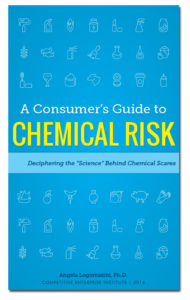It’s not too hard to see that “guilt by association” is unfair. After all, you might happen to be near the scene of a crime when it happens, but that doesn’t make you guilty of committing it. Unfortunately, many valuable consumer products are dubbed guilty of posing some grave health risk merely because of associations found in some statistical analysis. But using such associations alone to prove cause-and-effect relationships isn’t compelling science. In fact, many associations occur by mere accident or because of confounding factors.
Associations only become meaningful in the context of many other factors, such as the strength of the association, the sample size and suitability, the quality of the methodologies, sufficient control of confounding factors, and a weight-of-the evidence test. Studies that report weak associations are most suspect.
For example, news headlines have indicated that pregnant women should worry about the chemical Bisphenol A (BPA) because a “new study” says it increases the risk of miscarriage. In addition to the fact that the study was not published in any peer-reviewed journal, the association it reported was too weak to provide any meaningful conclusions.
The only part of this research that was available when the news broke on this “study” was an abstract produced for a presentation at a conference hosted by the American Society for Reproductive Medicine (ASRM).(1) Fortunately, the abstract provides enough information to allay fears, despite the headlines.(2)
Based on the abstract, we can see that the study examined 114 women in the early stages of pregnancy, who were high-risk group for miscarriage. The researchers took “spot samples” of the women’s blood and measured BPA in their blood serum. Sixty-eight of these women suffered from miscarriages, and the rest carried their babies to term.(3) The researchers then measured the BPA in the serum to see if those who miscarried had more BPA in their blood serum than the others. They then divided these 68 women into four groups based on the BPA exposure levels, ranging from those with the lowest to those with the highest. Using this data, the researchers calculated that those in the group with the highest BPA levels in their serum had an 80 percent higher risk of miscarrying than did those in the lowest-exposed group.(4)
Sounds pretty clear, right? Not so fast. These findings are not as meaningful as they might appear at first sight. First, all the researchers found was a weak association.
They report a 1.83 risk ratio for the highest risk group, which is low and suggests that the result may have arisen by accident or researcher bias. Researchers calculate risk ratios to determine the strength of an association. Risk ratios less than 2 or 3 are considered weak. For more details see this page on relative risk.
This study would be much stronger if it were consistent with the larger body of research, particularly the larger, best-designed studies, but it is not. Scientific panels around the world have reviewed the full body of BPA research repeatedly, and they all concluded that current consumer exposure to BPA is simply too low to have any adverse public health impacts.(5) The weight of the evidence, clearly, works against this weak study.
In addition, the sample size was very small and focused on a small subset of the population (women with high-risk pregnancies), which greatly increased the probability that the weak association was no more than accidental. Larger samples by definition are more representative of the larger population. Accordingly, if this sample was 10 or 20 times larger, an association would have greater meaning.
Finally, the methodology of this study was questionable. Researchers measured the BPA in the blood serum only once. Since BPA levels in the body can fluctuate considerably over time, one-time measures cannot reveal which women actually had higher exposures. Accordingly, the data going into this research were not good enough to draw conclusions.
Despite the obvious weaknesses of their claims, the researchers and others spun the issue to grab headlines. Lead researcher, Ruth B. Lathi of Stanford University notes in USA Today, that although she and her colleagues did not show that BPA is dangerous, “it’s far from reassuring that BPA is safe.”(6) But that comment may be safe to say because it is virtually impossible to prove absolute safety of anything—not even a glass of water.
Lathi also recommends avoiding plastic food packaging, not cooking in plastic food containers, and not leaving bottled water in the sun. Never mind that BPA is not used for most of these products, which she does not mention. There is no BPA in the lightweight, flexible plastic that makes single-use bottled water or plastic food storage containers such as GladWare, which is what Lathi seems to be suggesting we avoid. She also says to limit eating canned food.
BPA is used to make hard-clear plastics, such as the five-gallon water jugs used in office water coolers and safety goggles, and in resins that line canned goods to prevent rust and the development of deadly pathogens. Can Lathi assure us that removing those resins will be safe? Certainly not, yet her rhetoric advances policy in that direction.
Others in the scientific community have fanned the flames as well. Dr. Linda Giudice, president of the American Society for Reproductive Medicine, told reporters that although this research proves nothing, it adds to the “biological plausibility” that BPA affects fertility and health.(7) It is true that if something also has a potential biological explanation (plausibility), researchers can make a stronger argument for a cause-and-effect relationship, particularly if their study discovers a reasonably strong association. But using biological plausibility to rationalize a weak association is itself pretty weak.
In a press release, referencing this unpublished study, Giudice notes: “Many studies on environmental contaminants’ impact on reproductive capacity have been focused on infertility patients and it is clear that high levels of exposure affect them negatively. These studies extend our observations to the general population and show that these chemicals are a cause for concern to all of us.”(8)
This cryptic comment has no real relevance to the research at hand, even though Giudice placed it directly under the abstract in the press release. After all, what chemicals is she talking about? Who knows? It is clear that the high-level chemical exposures to which she refers have nothing to do with extremely low, easily metabolized trace levels of BPA. But her comment worked well for the alarmists in the media accounts alleging BPA-induced miscarriage risk.(9)
So beware of alarmist claims based on statistical studies that condemn chemicals based on mere associations, particularly weak associations. Often times these studies and the headlines will claim that their data “suggests” or that it shows a chemical is “linked to” some health effect. But this spin has little meaning.
Browse the terms on the sidebar of this webpage for more details and/or download a copy of A Consumer’s Guide to Chemical Risk: Deciphering the “Science” Behind Chemical Scares.


